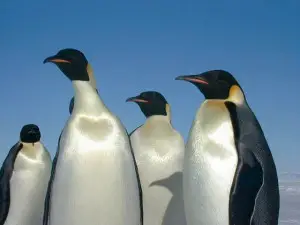
Penguins come from the order called Sphenisciformes. There are 17 species of penguins existing with about 40 species extinct. Scientists believe that penguins evolved from flying birds at least 65 million years ago during the Cretaceous Period. Through evolution, penguins became adapted to a sea environment.
Fact 1. Â Penguins who evolved into land birds are regarded as the fastest swimmers and deepest divers amongst birds.
Fact 2. Â Penguins of the Gentoo breed possess domestic inclinations. These penguins have long-lasting bonds and make hospitable nests for their offspring consisting of a circular nest of stones, grass, and other organic material. They share incubation duties and take care of their young for up to six months
Fact 3.   The size of Antarctica is larger than the combined area of the U.S. and Mexico, but the total suitable nesting size available for all penguins is the size of New York.
Fact 4. Â The Emperor penguins do not make nests but incubate their eggs by placing them on their feet to warm them protected by a flap called a brood pouch.
Fact 5. Â An adult penguin makes around 450 dives per day foraging for food.
Fact 6. Man is one of the predators faced by penguins. There have been incidents of 3,000 penguin eggs being salted in a day for voyage provisions.
Fact 7. Penguin oil has been used for heating, fuel, and tanning of leather. In the Falkland Islands, an estimated 2.6 million penguins have been decimated over a 16-year span for a purpose that was banned in 1918.
Fact 8.  The current climate change and rising sea levels are having a critical impact on Antarctica, the natural habitat of Adélie and Emperor penguins. Inevitably, the penguin population is declining due to the melting ice.
Fact 9. Abnormal weather changes, such as the El Nino, have influenced the temperature of the oceans and the food system of aquatic animals, ultimately affecting the food supply of the penguin population.
Fact 10. Pollution of the ocean waters in the form of chemicals and insoluble materials, such as plastics, has contributed to the decimation of penguins. Development of ecotourism, such as cruises to the Antarctic, has disturbed the ecosystem in the region impacting the food distribution systems. Commercialization of food such as krill and the Antarctic toothfish has had dire consequences.










Leave a Reply